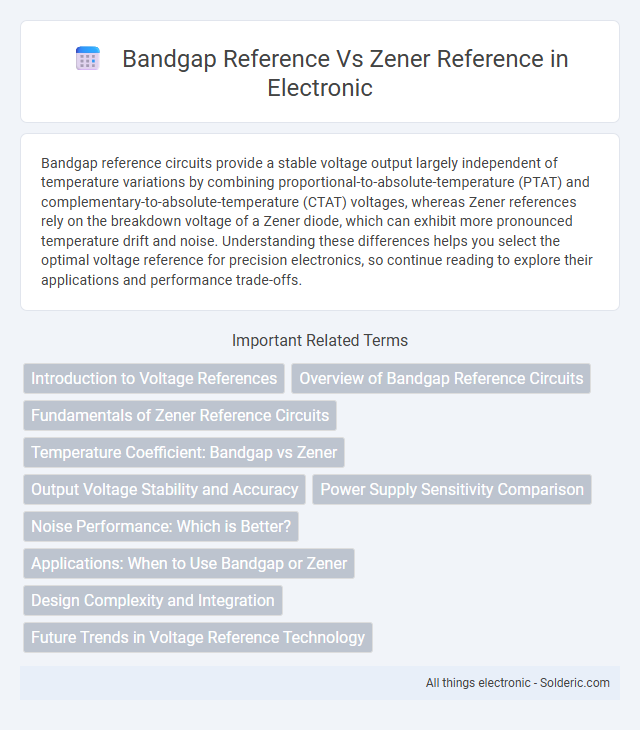Bandgap reference circuits provide a stable voltage output largely independent of temperature variations by combining proportional-to-absolute-temperature (PTAT) and complementary-to-absolute-temperature (CTAT) voltages, whereas Zener references rely on the breakdown voltage of a Zener diode, which can exhibit more pronounced temperature drift and noise. Understanding these differences helps you select the optimal voltage reference for precision electronics, so continue reading to explore their applications and performance trade-offs.
Comparison Table
| Feature | Bandgap Reference | Zener Reference |
|---|---|---|
| Temperature Stability | High stability (~ ppm/degC) | Moderate stability (~ mV/degC) |
| Voltage Output | Typically 1.2V | Typically 5.6V |
| Power Consumption | Low to moderate | Moderate to high |
| Complexity | Moderate, needs semiconductor junctions and op-amps | Simple, based on Zener diode breakdown |
| Process Integration | Fully integrable in ICs | Difficult to integrate, usually discrete |
| Noise Performance | Low noise | Higher noise levels |
| Cost | Higher due to complexity | Lower for discrete versions |
| Applications | Precision voltage references, ADCs, DACs | Voltage regulation, surge protection |
Introduction to Voltage References
Voltage references are essential components in electronic circuits, providing stable and precise voltage outputs regardless of temperature variations or power supply changes. Bandgap references utilize the predictable voltage of a silicon bandgap at approximately 1.25V, ensuring minimal temperature drift and stable performance across a wide range of conditions. Zener references rely on the Zener diode breakdown voltage, typically around 5.6V, offering a simple but less temperature-stable voltage source compared to bandgap references, making bandgap references preferable for high-precision applications requiring long-term stability.
Overview of Bandgap Reference Circuits
Bandgap reference circuits generate a stable voltage reference by combining the negative temperature coefficient of a diode's forward voltage with the positive temperature coefficient of a resistor, typically producing approximately 1.2 V near silicon's bandgap energy. This approach ensures excellent temperature stability and low power consumption, making bandgap references ideal for precision analog and mixed-signal integrated circuits. Compared to Zener references, bandgap circuits are less sensitive to noise and device aging, providing superior long-term voltage accuracy in modern semiconductor applications.
Fundamentals of Zener Reference Circuits
Zener reference circuits use the Zener diode's avalanche breakdown phenomenon to maintain a stable voltage regardless of temperature variations or supply fluctuations, making them ideal for precise voltage regulation. These circuits rely on the Zener diode's well-defined breakdown voltage, which typically ranges between 3V to 7V, to provide a consistent reference voltage in power supplies and measurement systems. Your designs benefit from the Zener reference's simplicity and robustness, though temperature coefficients and noise must be carefully managed to ensure long-term stability.
Temperature Coefficient: Bandgap vs Zener
Bandgap references exhibit a low and stable temperature coefficient, typically around 10 ppm/degC, making them ideal for precision voltage regulation across wide temperature ranges. In contrast, Zener references generally have higher temperature coefficients, often exceeding 50 ppm/degC, due to intrinsic Zener voltage variations with temperature. This significant difference in temperature stability makes bandgap references more suitable for applications demanding precise and consistent voltage outputs under varying thermal conditions.
Output Voltage Stability and Accuracy
Bandgap references provide superior output voltage stability and accuracy across temperature variations due to their inherent compensation techniques, maintaining a stable voltage typically around 1.2V. Zener references, while simpler, exhibit less precise voltage output and greater temperature dependency, often requiring higher power and careful temperature compensation for improved accuracy. Bandgap references are generally preferred in precision analog circuits where tight voltage regulation and low drift are critical.
Power Supply Sensitivity Comparison
Bandgap references exhibit lower power supply sensitivity compared to Zener references due to their design that relies on the stable bandgap voltage of silicon, typically around 1.2 V, making them less affected by supply voltage variations. Zener references often operate at higher voltages (typically 5.6 V) and rely on avalanche breakdown, which is more susceptible to changes in current caused by fluctuations in supply voltage. This makes bandgap references preferable in precision voltage regulation applications where minimizing power supply sensitivity is critical for maintaining accurate output voltage.
Noise Performance: Which is Better?
Bandgap references typically exhibit lower noise performance compared to Zener references, making them more suitable for precision analog circuits. Bandgap reference voltage sources generate a stable output with less flicker noise and thermal noise due to their semiconductor junction design. Zener references, while robust and simple, generally have higher noise levels arising from avalanche breakdown mechanisms, which can limit their use in low-noise applications.
Applications: When to Use Bandgap or Zener
Bandgap references are ideal for precision voltage regulation in integrated circuits, especially in temperature-sensitive analog and mixed-signal applications requiring stable low-voltage references around 1.2V. Zener references are preferred in high-voltage environments and discrete component designs where durability and robustness against voltage spikes are critical, commonly used in power supplies and voltage clamping. Choosing between bandgap and Zener depends on application voltage range, integration level, and required temperature stability.
Design Complexity and Integration
Bandgap references feature moderate design complexity with well-understood semiconductor processes suitable for integration in CMOS technology, enabling low voltage operation and thermal stability. Zener references involve higher design complexity due to avalanche breakdown mechanisms, requiring thicker junctions and higher voltages, which complicate integration in standard IC processes. Bandgap references offer superior compatibility with modern low-voltage integrated circuits compared to Zener references, making them preferred for on-chip voltage regulation and analog precision applications.
Future Trends in Voltage Reference Technology
Bandgap reference circuits are evolving with advancements in low-power design and temperature stability, driving their adoption in precise analog and mixed-signal integrated circuits. Zener references, while traditionally favored for high-voltage applications, face limitations in scalability and noise performance, prompting research into alternative materials and fabrication techniques. Emerging trends emphasize integration of bandgap references with digital calibration and adaptive compensation to meet the demands of next-generation IoT, wearable, and automotive electronics.
Bandgap reference vs Zener reference Infographic

 solderic.com
solderic.com